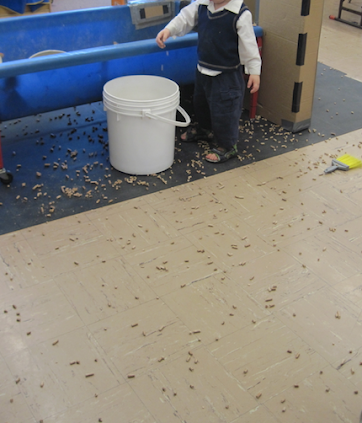Because I am often asked what materials I use in my sand and water table, I am writing a series of posts about those materials. I started to introduce some of those materials in posts about two of my favorite materials: sticks and rocks. I also wrote about a couple of the most elemental materials I use in the table, namely, water and sand. (By the way, water comes in different states and there are several different types of sand.) In February, I wrote a post on feed corn.
In this post, I write about wood pellets. Wood pellets are made of compressed saw dust and are burned in pellet stoves to heat a house. They are also used for grilling. There are softwood pellets and hardwood pellets. I generally used pellets made from pine saw dust.
Before I write about the pellets, there is a story behind how I discovered them. One year I had a child in my classroom who had so many allergies to food that the parent was introducing one food at a time to see if the child could tolerate it. I had been using feed corn because I really liked its unique properties for children's play and exploration. Even though feed corn is ostensibly for animals, it was close enough to food that I removed it as a medium from my sensory table. Thus began a quest to find a medium with similar properties. I found what I was looking for in a big box hardware store in the form of wood pellets.
So what are some of the unique properties of wood pellets as a medium that are similar to feed corn? First, the wood pellets come in small, light bits much like feed corn. Those properties invite children to collect the wood pellets and corn kernels to fill their containers
My point is well made with two pictures from my archives. In the picture above a child fills multiple containers with pellets. In the picture below, two children fill whatever container they find with a mix of pellets and feed corn.
Like the kernels in feed corn, pellets require the children to use their pincer grip to handle the individual pieces.
Another similarity with feed corn is how the wood pellets flow down an incline tube. Water and sand flow in a continuous stream, but with the pellets there is a discernible dispersion pattern as they drop out of the tube.
This is a setup in which a big box is partially embedded in the sensory table. Children at the top of the tube pour pellets down and the child in the box plugs the lower end with a small plastic pail. When the tube is full, the child in the box pulls the plug and the pellets come gushing out.
Much like the feed corn, the pellets seem to invite and even encourage children to totally immerse their hands and arms as they explore the medium.
In one cubicle, the child in orange has buried his hands and arms in the mass of wood pellets. He is helped by the child in the stripes who gathers more pellets from another cubicle to add to the mass of pellets and further bury the other child's hands and arms. The middle cubicle is already empty so you know this is a joint endeavor that is taking time and persistence.
Yet another property that wood pellets have in common with the feed corn is the popping sound they make when they are poured into a tub
There are at least two properties that differentiate wood pellets from feed corn. One is the smell. Wood pellets smell like wood and feed corn smells like, well, corn. This is the sensory table and smell is part of the experience.
Another difference between the wood pellets and the feed corn is the shape. The feed corn has flat sides; the wood pellets are little round cylinders.
Because the pellets are round they roll and can make quite a mess. However, said mess is a great opportunity for children---given the right tools---to help take care of the room with real work.
When that family left the program, I brought back the feed corn. However, I do owe a debt of gratitude to the mom and child who set me on my quest to find a substitute for feed corn. And because of that, I gained a new medium with unique properties that I could rotate from time to time into the sensory table.






